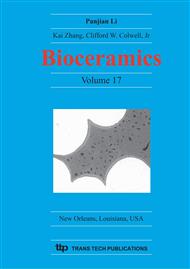p.749
p.753
p.757
p.761
p.765
p.769
p.775
p.779
p.783
Evaluation of a Chitosan Nano-Hybrid Material Containing Silanol Group and Calcium Salt as a Bioactive Bone Graft
Abstract:
A bioactive chitosan-siloxane nano-hybrid material was newly developed and evaluated for the potential application as a bone graft material. The chitosan which can be dissolved in organic solvent was synthesized by the reaction with phtalic anhydride (Ph-Chitosan) and it was then reacted with 3-isocyanatopropyl triethoxysilane (Si-Chitosan) in dimethylformamide. Following this, the Si-Chitosan was hydrolyzed and condensed to yield a hybrid sol-gel material (Si-O-Chitosan). The gelation was carried out for 1 week at ambient condition in a covered Teflon mold with a few pinholes and then dried under vacuum at room temperature for 48 h. The bioactivity of the chitosan nano-hybrid material was evaluated by examining the apatite forming ability in the simulated body fluid (SBF). The surface microstructure and functional groups of the specimen was analyzed by field emission scanning electron microscopy and Fourier transformed infrared spectroscopy, respectively. The crystal phases of the specimen before and after the bioactivity testing were analyzed by thin film X-ray diffractometry. Newly developed chitosan nano-hybrid material showed apatite-forming ability in the SBF within 1 week soaking and this ability was believed to come from the silanol group formed on the surface of Si-O-Chitosan and calcium salt which increased the ionic activity product of apatite in the SBF.
Info:
Periodical:
Pages:
765-768
Citation:
Online since:
April 2005
Authors:
Keywords:
Price:
Сopyright:
© 2005 Trans Tech Publications Ltd. All Rights Reserved
Share:
Citation:


